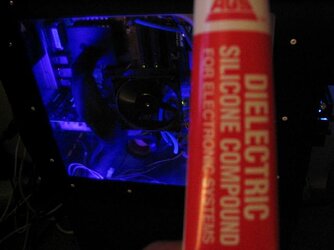Dielectric grease + Prometeia heating element?
Hey guys. I'm trying to beef up my insulation and I need some help.
I have a Prometeia Mach 1 and I haven't been using dielectric greese to insulate my mobo's components around the cpu socket and the back of the board, and I almost learned my lesson the expensive way...
I was running my system as always, just checking my o/c, seeing if I could go higher, ect... when I came back to my machine after being away for a few hours and found that my system had completely hard-locked. I thought it was a little odd a first, as usually my system will just reboot if I push it too far. Anyways, I went to reboot the system, and I couldn't even get my machine to POST. I tried everything I could think of, but I still couldn't get my machine to boot up.
I ended up taking my entire system apart and started testing each individual component out in my secondary rig. I had it narrowed down to being either my CPU or my motherboard. Well when I removed the Prometeia back side heating element (comes standard with Mach II units) from my motherboard, I noticed that there was this weird yellow-green residue on top of some of the components and leads that had been underneath the heating element. It looked like corrosion to me.
Anyways, I cleaned this residue off of the components with some isopropyl alchohal and made sure that everything was clean. I put my system back together, just using air cooling for now, and hit the power button. It booted up, and everything is working like new again.
So obviously it was this residue (corrosion?) on the back of my motherboard that was causing some the leads to short out and prevent my system from working properly. I want to keep this from happening again, so I read up on insulation for extreme cooling, ect, and I'm now going to cover the cpu socket and all the socket holes with dielectric grease. Now I also want to cover the back part of the board, where the heating element is placed, as that is the problem area for whatever reason.
My question is: do I still use the heating element with the dielectric grease covering the back of my board? Or do I just keep the heating element unplugged, but still mount the plastic frame to the back of the board, with the dielectric grease still covering the components?
Hey guys. I'm trying to beef up my insulation and I need some help.
I have a Prometeia Mach 1 and I haven't been using dielectric greese to insulate my mobo's components around the cpu socket and the back of the board, and I almost learned my lesson the expensive way...
I was running my system as always, just checking my o/c, seeing if I could go higher, ect... when I came back to my machine after being away for a few hours and found that my system had completely hard-locked. I thought it was a little odd a first, as usually my system will just reboot if I push it too far. Anyways, I went to reboot the system, and I couldn't even get my machine to POST. I tried everything I could think of, but I still couldn't get my machine to boot up.
I ended up taking my entire system apart and started testing each individual component out in my secondary rig. I had it narrowed down to being either my CPU or my motherboard. Well when I removed the Prometeia back side heating element (comes standard with Mach II units) from my motherboard, I noticed that there was this weird yellow-green residue on top of some of the components and leads that had been underneath the heating element. It looked like corrosion to me.
Anyways, I cleaned this residue off of the components with some isopropyl alchohal and made sure that everything was clean. I put my system back together, just using air cooling for now, and hit the power button. It booted up, and everything is working like new again.
So obviously it was this residue (corrosion?) on the back of my motherboard that was causing some the leads to short out and prevent my system from working properly. I want to keep this from happening again, so I read up on insulation for extreme cooling, ect, and I'm now going to cover the cpu socket and all the socket holes with dielectric grease. Now I also want to cover the back part of the board, where the heating element is placed, as that is the problem area for whatever reason.
My question is: do I still use the heating element with the dielectric grease covering the back of my board? Or do I just keep the heating element unplugged, but still mount the plastic frame to the back of the board, with the dielectric grease still covering the components?
Last edited:


